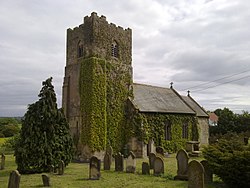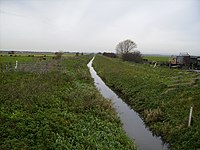Folkton
| Folkton | |
| Yorkshire East Riding | |
|---|---|
 Church of St John the Evangelist, Folkton | |
| Location | |
| Grid reference: | TA054797 |
| Location: | 54°12’8"N, 0°23’6"W |
| Data | |
| Population: | 535 (2011 census) |
| Post town: | Scarborough |
| Postcode: | YO11 |
| Local Government | |
| Council: | North Yorkshire |
| Parliamentary constituency: |
Thirsk and Malton |
Folkton is a small village at the foot of the Yorkshire Wolds and on the edge of the Vale of Pickering on an area known as Folkton Carr ('carr' meaning low lands) in the East Riding of Yorkshire, close to the bounds of the North Riding.
There is a church here dedicated to St John the Evangelist. Folkton House, the former rectory is located on Filey Road. Towards Flixton is the former village school which is now closed, built in 1832.
The 2011 Census recorded a parish population of 535.
Contents
Geography
Folkton Carr, the lowlying land of the area, was once fenland. In a prehistoric time it lay below Lake Pickering.
To the south are the Wolds and further north, across the Carrs and up the hills at the other side of the Vale is Scarborough, beyond which to the north-west are the Yorkshire Moors.
History
Above the village, at the top of Folkton Hill, the Folkton Drums were discovered: a set of Stone Age bowl-shaped chalk carvings, discovered by William Greenwell in 1889.[1] They were buried in a tumulus that sits at the intersection of several natural pathways through the Dales. They can now be seen on display at the British Museum.[2]
The Carr would have historically been lake or marsh in succeeding eras. Its natural state today would be as marsh land but it was drained in the 19th century to make room for agriculture.
The village as it stands today was established with a small number of farm houses around 400 years ago. Later building added to and expanded these existing structures into larger houses and farms with attached barns. Many barns were then demolished during the 1800s to avoid the 'Roof Tax'.
In 1823 the Folkton parish was noted as a village in the Dickering Wapentake. The population at the time was 144. Occupations included three farmers, and the landlady of The Bell public house. Two miles to the west of the village, in the Folkton parish, and separated by one mile, were the settlements of East and West Flotmanby, each listed with a gentleman.[3]
Outside links
| ("Wikimedia Commons" has material about Folkton) |
References
- ↑ North, John (1996). Stonehenge : a new interpretation of prehistoric man and the cosmos. New York, NY: The Free Press. ISBN 1416576460. https://books.google.com/books?isbn=1416576460. Retrieved 31 July 2014.
- ↑ "The Folkton drums", The British Museum
- ↑ Baines, Edward: 'History, Directory and Gazetteer of the County of York' (1823); pages 206-207

